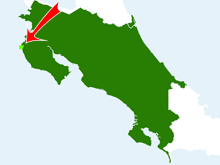Las Baulas National Marine Park - Costa Rica
One of the most beautiful beaches, Playa Grande, is situated inside the national park. This spot is well known amongst surfers. Boasting good wave conditions, left and right breaks over a sandy bottom.
The Las Baulas National Park was created in 1990 to support the nesting colony of leatherback sea turtles. Mostly leatherback sea turtles come ashore to lay their eggs. Olive ridley sea turtles, green sea turtles and hawksbill sea turtles come in smaller quantities to this beach.
Leatherback sea turtles can weigh up 900kg, swim thousands of miles and dive up to 1200 meters deep (deeper than any other turtle).
Mature female leatherback turtles return to the same beach to nest every few years. Scientists are still trying to understand how they navigate and find their way back to the same beach. Female leatherback turtles emerge at night on beaches to lay their eggs. Turtle tours commence in the late afternoon, or after sunset.
Only with a guided tour can you go onto the beaches at night during the arribada. Turtle nesting season at this beach is from October till March. Most of them come between November and December. Do not take pictures using flashes, otherwise you may scare her back into the sea.
Observing the nesting of leatherback sea turtles...
Do not shine light on the turtle because this can cause her to stop laying eggs as well.
On the southern part of Playa Grande extends the mangrove estuary of the Rio Matapalo. Across the river lies Playa Tamarindo.
Las Baulas National Marine Park on the map

Facts about Las Baulas National Marine Park, Costa Rica
- The Las Baulas National Marine Park is an important protection area for the sea turtles.
- Most of the turtles come between November and December in the Las Baulas National Marine Park to lay there eggs.
- Only with guides it is allowed to observe the turtles laying there eggs in the Las Baulas National Marine Park.

